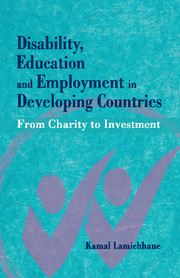Book contents
- Frontmatter
- Contents
- List of Tables and Figures
- Preface
- Acknowledgements
- 1 Fundamentals of Disability Studies
- 2 Disability and the Global Employment Situation
- 3 Disability and the Role of Education in Jobs: Case Studies from Nepal and the Philippines
- 4 Disability and Jobs in a Post-Conflict Country: Cambodia
- 5 Gender and Jobs: A Comparison between People with and without Disabilities in Bangladesh
- 6 Disability and Human Capital Investment
- 7 Disability, Poverty and Inequality: A Case Study in Nepal
- 8 Disability and Job Satisfaction Differentials
- 9 Disability and Determinants of Education: A Case from India
- 10 Disability and Barriers to Education
- 11 The Way Forward: Investment in Disability
- Index
- About the Author
10 - Disability and Barriers to Education
Published online by Cambridge University Press: 05 February 2015
- Frontmatter
- Contents
- List of Tables and Figures
- Preface
- Acknowledgements
- 1 Fundamentals of Disability Studies
- 2 Disability and the Global Employment Situation
- 3 Disability and the Role of Education in Jobs: Case Studies from Nepal and the Philippines
- 4 Disability and Jobs in a Post-Conflict Country: Cambodia
- 5 Gender and Jobs: A Comparison between People with and without Disabilities in Bangladesh
- 6 Disability and Human Capital Investment
- 7 Disability, Poverty and Inequality: A Case Study in Nepal
- 8 Disability and Job Satisfaction Differentials
- 9 Disability and Determinants of Education: A Case from India
- 10 Disability and Barriers to Education
- 11 The Way Forward: Investment in Disability
- Index
- About the Author
Summary
Introduction
Using the available dataset from Nepal, this chapter further discusses barriers to the education of people with disabilities and seeks to answer the following questions: What are the historical and contemporary factors barring individuals with disabilities from continued access to education, and are these factors different depending on the type of impairments? What are the facilities available for students with disabilities in the resource classes of integrated educational programmes? What are the adjustments made by teachers while teaching students with disabilities in mainstream classes? To answer these questions, this chapter discusses the educational situation of people with disabilities with the particular focus on people with hearing, physical and visual impairments. It also includes perspectives from teachers teaching students with visual impairments prior to their placement in mainstream classes and discusses the existing situation and availability of facilities for students with visual impairments in integrated educational settings. One of the crucial issues regarding access to quality education for people with disabilities is whether mainstream school teachers are able to effectively adjust their teaching styles to meet the individual needs of these students. It is important, therefore, for this chapter to paint a full picture of the educational situation for people with disabilities in Nepal. The rest of the chapter is organized as follows: Section 2 includes background information on disabilities and the available educational options; Section 3 discusses barriers to education facing three types of impairment groups; Section 4 further discusses difficulties in the integrated education system for people with visual impairments; finally, Section 5 presents concluding remarks.
Available educational options
This section presents the historically and contemporarily available educational options for people with disabilities. Both around the world and in Nepal, the main educational options available are special educational programmes, integrated educational programmes and inclusive education. Within Nepal, special schools are available specifically for students with hearing impairments that have appropriate equipment and teacher training to match the students' educational needs, whereas students with visual impairments primarily attend integrated schools.
- Type
- Chapter
- Information
- Disability, Education and Employment in Developing CountriesFrom Charity to Investment, pp. 212 - 245Publisher: Cambridge University PressPrint publication year: 2015
- 1
- Cited by



